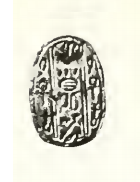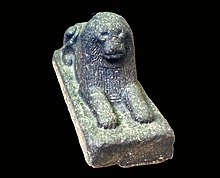This is an old revision of this page, as edited by Iry-Hor (talk | contribs) at 09:48, 26 December 2020. The present address (URL) is a permanent link to this revision, which may differ significantly from the current revision.
Revision as of 09:48, 26 December 2020 by Iry-Hor (talk | contribs)(diff) ← Previous revision | Latest revision (diff) | Newer revision → (diff) "Khian" redirects here. For village in Eastern Anatolia, see Salkımlı, Kulp.| Khyan | |||||||||||||||||||||||||||||||||||||||||||||||||||||||||||||||||||||||
|---|---|---|---|---|---|---|---|---|---|---|---|---|---|---|---|---|---|---|---|---|---|---|---|---|---|---|---|---|---|---|---|---|---|---|---|---|---|---|---|---|---|---|---|---|---|---|---|---|---|---|---|---|---|---|---|---|---|---|---|---|---|---|---|---|---|---|---|---|---|---|---|
 Remains of a statue of the Twelfth Dynasty reappropriated by Hyksos ruler Khyan, with his name inscribed on the sides over an erasure. Remains of a statue of the Twelfth Dynasty reappropriated by Hyksos ruler Khyan, with his name inscribed on the sides over an erasure. | |||||||||||||||||||||||||||||||||||||||||||||||||||||||||||||||||||||||
| Pharaoh | |||||||||||||||||||||||||||||||||||||||||||||||||||||||||||||||||||||||
| Reign | 1610?–1580 BC | ||||||||||||||||||||||||||||||||||||||||||||||||||||||||||||||||||||||
| Predecessor | Sakir-Har | ||||||||||||||||||||||||||||||||||||||||||||||||||||||||||||||||||||||
| Successor | Apepi | ||||||||||||||||||||||||||||||||||||||||||||||||||||||||||||||||||||||
Royal titulary
| |||||||||||||||||||||||||||||||||||||||||||||||||||||||||||||||||||||||
| Children | Yanassi | ||||||||||||||||||||||||||||||||||||||||||||||||||||||||||||||||||||||
| Died | 1580 BC | ||||||||||||||||||||||||||||||||||||||||||||||||||||||||||||||||||||||
| Monuments | A Stela in Avaris | ||||||||||||||||||||||||||||||||||||||||||||||||||||||||||||||||||||||
| Dynasty | 15th Dynasty | ||||||||||||||||||||||||||||||||||||||||||||||||||||||||||||||||||||||
Seuserenre Khyan (also Khayan or Khian) was an Hyksos king of the Fifteenth Dynasty of Egypt, ruling over Lower Egypt in the second half of the 17th century BCE. His royal name Seuserenre translates as "The one whom Re has caused to be strong." Khyan bears the titles of an Egyptian king, but also the title ruler of the foreign land (heqa-khaset). The later title is the typical designation of the Hyksos rulers.
Khyan is one of the better attested kings from the Hyksos period, known from many seals and seal impressions. Remarkable are objects with his name found at Knossos and Hattusha indicating diplomatic contacts with Crete and the Hittites. A sphinx with his name was bought on the art market at Baghdad and might demonstrate diplomatic contacts to Babylon, in an example of Egypt-Mesopotamia relations.
Hyksos Kingdom
At the time of Khyan's reign, the Hyksos kings ruled over Lower Egypt and may have dominated the Nile Valley as far south as Thebes, forcing the native Egyptian kingdom there into a vassal state. Khyan's seat of power was located in Avaris, which hosted a strongly fortified palace. Seal impressions of Khyan and of one of his son, prince Yanassi, were found there during excavations, confirming his presence onsite. The palace, destroyed during the later conquest of the Hyksos' kingdom by the Thebans under Ahmose I, was decorated with painted murals in Cretan styles and motifs, suggesting far-reaching cultural and commercial exchanges during Khyan's reign. The palace comprised a high platform built on massive brick casemates surrounded by columned halls and monumental staircases leading to a still higher platform, on which the royal apartments probably stood. Further East, the Hyksos controlled the massive 350 m × 400 m (1,150 ft × 1,310 ft) fortress of Tjaru on the road to Sinai and Canaan, where stelae of Khyan's successor Apophis were uncovered.
Khyan's position in the Hyksos dynasty


Khyan is identified with king Iannas in the works of Josephus whose knowledge of the Hyksos Pharaohs was derived from a history of Egypt written by Manetho. Josephus mentions him after Apophis when discussing the reign lengths of kings who ruled after Salitis. This led 18th century scholars such as Arthur Bedford to place Khyan after Apophis, towards the end of the Hyksos dynasty. However, in Sextus Julius Africanus' version of Manetho's Epitome, Khyan (whose name is transcribed there as Staan) is listed after a king Pachnan, perhaps Yaqub-Har. Stylistically Khyan's scarabs resemble closely those of Yaqub-Har, who might date rather to the beginning and not to the end of the Hyksos-period. This indicates that Khyan was one of the earlier rulers of the 15th dynasty.
The early position of Khyan within the 15th dynasty may be confirmed by new archaeological finds at Edfu. On this site were found seal impressions of Khyan in close connection with seal impressions of the 13th Dynasty king Sobekhotep IV, indicating that both kings could have reigned at about the same time. The scholars Moeller and Marouard discuss the discovery of an important early 12th dynasty Middle Kingdom administrative building in the eastern Tell Edfu area which was continuously employed into the early Second Intermediate Period before it fell out of use during the 17th dynasty when its remains were sealed by a large silo court. Fieldwork by Egyptologists in 2010 and 2011 into the remains of the former 12th dynasty building which was also used in the 13th dynasty led to the discovery of a large adjoining hall which proved to contain 41 sealings showing the cartouche of the Hyksos ruler Khyan together with 9 sealings naming the 13th dynasty king Sobekhotep IV. As Moeller and Marouard write: "These finds come from a secure and sealed archaeological context and open up new questions about the cultural and chronological evolution of the late Middle Kingdom and early Second Intermediate Period." These conclusions are rejected by Robert Porter who argues that Khyan ruled much later than Sobekhotep IV and that the seals of a pharaoh were used even long after his death. Another option he proposed is that Sobekhotep IV reigned much later than previously thought.


| |
A stela of Khyan mentioning a king's son' was also discovered at Avaris. Manfred Bietak observed that: "a stela set up in Avaris contains the nomen and prenomen of Khyan and a now lost dedication (presumably to Seth, Lord of Avaris) below which are inscribed the title and name of the Eldest King's Son Yanassi."
The Danish Egyptologist Kim Ryholt, who published an extensive catalogue of the monuments of all the numerous pharaohs of the Second Intermediate Period, notes an important personal detail regarding this king's family; Ryholt writes that the association of Khyan with those of his eldest son upon this stela suggests that Yanassi in fact was his designated successor, as also implied by his title." Ryholt speculates that Manetho might have mentioned Yanassi in a now lost passage and that one possible explanation of the name Iannas used by Josephus for Khyan is a misquotation of such a passage in which the son's name was extracted instead of the father's.
Origin of Khyan's name
| ||||||
| Khyan in hieroglyphs | ||||||
|---|---|---|---|---|---|---|
| Era: 2nd Intermediate Period (1650–1550 BC) | ||||||
Ryholt notes that the name, Khyan, generally has been "interpreted as Amorite Hayanu (reading h-ya-a-n) which the Egyptian form represents perfectly, and this is in all likelihood the correct interpretation." It should be stressed that Khyan's name was not original and had been in use for centuries before the fifteenth (Hyksos) Dynasty. The name Hayanu is recorded in the Assyrian king lists—see "Khorsabad List I, 17 and the SDAS List, I, 16"--"for a remote ancestor of Shamshi-Adad I (c.1800 BC)."
References
- "The name of Khyan on the statue from Bubastis is written over an erasure , that the statue is of the XIIth Dynasty , and that Khyan was a Hyksôs king" in Griffith, F. Ll. Archaeological Report 1890/91 - 1911/12: Comprising the Recent Work of the Egypt Exploration Fund and the Progress of Egyptology During the Year 1890/91-1911/12. Kegan Paul, Trench, Trübner. p. 28.
- Khiyan Titulary Archived 2007-09-27 at the Wayback Machine
- Rohl, David (2010). The Lords Of Avaris. Random House. p. 216. ISBN 978-1-4070-1092-2.
- Weigall, Arthur E. P. Brome (2016). A History of the Pharaohs. Cambridge University Press. p. 188. ISBN 978-1-108-08291-4.
- "Statue British Museum". The British Museum.
- Mumford 2001b, p. 339.
- Tyson Smith 2001, p. 30.
- ^ Stadelmann 2001, p. 14.
- Bietak 2007, p. 753.
- Bietak 1981, pp. 63–71.
- M. Bietak: A Hyksos Palace at Avaris, In: Egyptian Archaeology 38 Spring 2011, S. 38-41
- Mumford 2001a, p. 289.
- Flinders Petrie: Scarabs and cylinders with names (1917), available copyright-free here, pl. XXI
- W. Ward, in; O. Tufnell: Scarabs and their Contribution to History in the Early Second Millennium B.C., Warminster 1984, 68, fig. 29
- A scarab of Khyan at the Metropolitan Museum of Art.
- N. Moeller, G. Marouard, N. Ayers: Discussion of Late Middle Kingdom and Early Second Intermediate Period History and Chronology in Relation to the Khayan Sealings from Tell Edfu, in: Ägypten und Levante XXI (2011), 87-121 online PDF
- N. Moeller, G. Maround, N. Ayers, Ägypten und Levante XXI (2011), p.87
- Robert M. Porter: The Second Intermediate Period according to Edfu, Goettinger Mizsellen 239 (2013), p. 75-80
- Rohl, David (2010). The Lords Of Avaris. Random House. p. 216. ISBN 978-1-4070-1092-2.
- Weigall, Arthur E. P. Brome (2016). A History of the Pharaohs. Cambridge University Press. p. 188. ISBN 978-1-108-08291-4.
- "Statue British Museum". The British Museum.
- Manfred Bietak, MDAIK 37, pp.63-71, pl.6
- ^ Kim SB Ryholt, The Political Situation in Egypt during the Second Intermediate Period, CNI Publications, (Museum Tusculanum Press: 1997), p.256
- Khiyan Titulary Archived 2007-09-27 at the Wayback Machine (by Jacques Kinnaer, Belgian Egyptologist)
- ^ Ryholt, p.128
Bibliography
- Bietak, Manfred (1981). "Eine Stele des ältesten Königssohnes des Hyksos Chajan". Mitteilungen des Deutschen Archäologischen Instituts, Abteilung Kairo (in German). 37, Labib Habachi Festschrift: 63–71.
{{cite journal}}: Invalid|ref=harv(help) - Bietak, Manfred (2007). "Où est le palais des Hyksôs ? À propos des fouilles à Tell el-Dabca et 'Ezbet Helmi". Comptes rendus des séances de l'Académie des Inscriptions et Belles-Lettres (in French): 749–780.
{{cite journal}}: Invalid|ref=harv(help) - Mumford, Gregory (2001a). "Sinai". In Redford, Donald B. (ed.). The Oxford Encyclopedia of Ancient Egypt, Volume 3. Oxford: Oxford University Press. pp. 288–292. ISBN 978-0-19-510234-5.
- Mumford, Gregory (2001b). "Syria-Palestine". In Redford, Donald B. (ed.). The Oxford Encyclopedia of Ancient Egypt, Volume 3. Oxford: Oxford University Press. pp. 335–343. ISBN 978-0-19-510234-5.
- Stadelmann, Rainer (2001). "Palaces". In Redford, Donald B. (ed.). The Oxford Encyclopedia of Ancient Egypt, Volume 3. Oxford: Oxford University Press. pp. 13–17. ISBN 978-0-19-510234-5.
- Tyson Smith, Stuart (2001). "People". In Redford, Donald B. (ed.). The Oxford Encyclopedia of Ancient Egypt, Volume 3. Oxford: Oxford University Press. pp. 27–33. ISBN 978-0-19-510234-5.
Further reading
- Irene Forster-Müller, Nadine Moeller (eds.), The Hyksos Ruler Khyan and the Early Second Intermediate Period in Egypt: Problems and Priorities of Current Research. Proceedings of the Workshop of the Austrian Archaeological Institute and the Oriental Institute of the University of Chicago, Vienna, July 4–5, 2014.(online)
| Preceded bySakir-Har | Pharaoh of Egypt Fifteenth Dynasty |
Succeeded byApepi |
